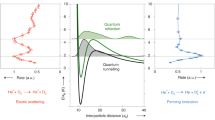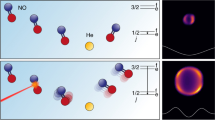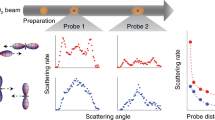Abstract
In molecular collisions, long-lived complexes may be formed that correspond to quasi-bound states in the van der Waals potential and give rise to peaks in the collision energy-dependent cross-sections. They are known as ‘resonances’ and their experimental detection remains difficult because their signatures are extremely challenging to resolve. Here, we show a complete characterization of quantum-dynamical resonances occurring in CO–He inelastic collisions with rotational CO(j = 0  1) excitation. Crossed-beam scattering experiments were performed at collision energies as low as 4 cm−1, equivalent to a temperature of 4 K. Resonance structures in the measured cross-sections were identified by comparison with quantum-mechanical calculations. The excellent agreement found confirms that the potential energy surfaces describing the CO–He van der Waals interaction are perfectly suitable for calculating state-to-state (de)excitation rate coefficients at the very low temperatures needed in chemical modelling of the interstellar medium. We also computed these rate coefficients.
1) excitation. Crossed-beam scattering experiments were performed at collision energies as low as 4 cm−1, equivalent to a temperature of 4 K. Resonance structures in the measured cross-sections were identified by comparison with quantum-mechanical calculations. The excellent agreement found confirms that the potential energy surfaces describing the CO–He van der Waals interaction are perfectly suitable for calculating state-to-state (de)excitation rate coefficients at the very low temperatures needed in chemical modelling of the interstellar medium. We also computed these rate coefficients.
This is a preview of subscription content, access via your institution
Access options
Subscribe to this journal
Receive 12 print issues and online access
$259.00 per year
only $21.58 per issue
Buy this article
- Purchase on Springer Link
- Instant access to full article PDF
Prices may be subject to local taxes which are calculated during checkout


 CO(j = 1) + He inelastic collisions.
CO(j = 1) + He inelastic collisions.

Similar content being viewed by others
References
Levine, R. D. & Bernstein, R. B. Molecular Reaction Dynamics and Chemical Reactivity (Oxford Univ. Press, 1987).
Wernli, M. et al. Improved low-temperature rate constants for rotational excitation of CO by H2 . Astron. Astrophys. 446, 367–372 (2006).
Cecchi-Pestellini, C., Bodo, E., Balakrishnan, N. & Dalgarno, A. Rotational and vibrational excitation of CO molecules by collisions with 4He atoms. Astrophys. J. 571, 1015–1020 (2002).
Chefdeville, S. et al. Appearance of low energy resonances in CO–para-H2 inelastic collisions. Phys. Rev. Lett. 109, 023201 (2012).
Chefdeville, S. et al. Observation of partial wave resonances in low-energy O2–H2 inelastic collisions. Science 341, 1094–1096 (2013).
Lique, F. et al. Collisional excitation of O2 by H2: the validity of LTE models in interpreting O2 observations. Astron. Astrophys. 567, A22 (2014).
Lique, F. Temperature dependence of the fine-structure resolved rate coefficients for collisions of O2(X3Σg−) with He. J. Chem. Phys. 132, 044311 (2010).
Kalugina, Y., Kłos, J. & Lique, F. Collisional excitation of CN(X2Σ+) by para- and ortho-H2: fine-structure resolved transitions. J. Chem. Phys. 139, 074301 (2013).
Lique, F. et al. Rotational excitation of CN(X2Σ+) by He: theory and comparison with experiments. J. Chem. Phys. 132, 024303 (2010).
Gubbels, K. B. et al. Resonances in rotationally inelastic scattering of OH(X2Π) with helium and neon. J. Chem. Phys. 136, 144308 (2012).
Yang, B. & Stancil, P. C. Close-coupling study of rotational energy transfer and differential scattering in H2O collisions with He atoms. J. Chem. Phys. 126, 154306 (2007).
Scribano, Y., Faure, A. & Wiesenfeld, L. Rotational excitation of interstellar heavy water by hydrogen molecules. J. Chem. Phys. 133, 231105 (2010).
Gubbels, K. B., van de Meerakker, S. Y. T., Groenenboom, G. C., Meijer, G. & van der Avoird, A. Scattering resonances in slow NH3–He collisions. J. Chem. Phys. 136, 074301 (2012).
Chandler, D. W. Cold and ultracold molecules: spotlight on orbiting resonances. J. Chem. Phys. 132, 110901 (2010).
Casavecchia, P. & Alexander, M. H. Uncloaking the quantum nature of inelastic molecular collisions. Science 341, 1076–1077 (2013).
Liu, K. in Advances in Chemical Physics Vol. 149 (eds Rice, S. A. & Dinner, A. R.) 1–46 (Wiley, 2012).
Naulin, C. & Costes, M. Experimental search for scattering resonances in near cold molecular collisions. Int. Rev. Phys. Chem. 33, 427–446 (2014).
Henson, A. B., Gersten, S., Shagam, Y., Narevicius, J. & Narevicius, E. Observation of resonances in Penning ionization reactions at sub-kelvin temperatures in merged beams. Science 338, 234–238 (2012).
Lavert-Ofir, E. et al. Observation of the isotope effect in sub-kelvin reactions. Nature Chem. 6, 332–335 (2014).
Jankunas, J., Bertsche, B., Jachymski, K., Hapka, M. & Osterwalder, A. Dynamics of gas phase Ne*+NH3 and Ne*+ND3 Penning ionisation at low temperatures. J. Chem. Phys. 140, 244302 (2014).
Schutte, A., Bassi, D., Tommasini, F. & Scoles, G. Orbiting resonances in the scattering of H atoms by mercury at thermal energies. Phys. Rev. Lett. 29, 979–982 (1972).
Toennies, J. P., Welz, W. & Wolf, G. Molecular beam scattering studies of orbiting resonances and the determination of van der Waals potentials for H–Ne, Ar, Kr, and Xe and for H2–Ar, Kr, and Xe. J. Chem. Phys. 71, 614–642 (1979).
Antonova, S., Lin, A., Tsakotellis, A. P. & McBane, G. C. State to state He–CO rotationally inelastic scattering. J. Chem. Phys. 110, 2384–2390 (1999).
Fujii, A., Ebata, T. & Ito, M. Production of rotationally state selected ions by resonant enhanced multiphoton ionization of CO in a supersonic free jet. Chem. Phys. Lett. 161, 93–97 (1989).
Hines, M. A., Michelsen, H. A. & Zare, R. N. 2+1 resonantly enhanced multiphoton ionization of CO via the E1Π–X1Σ+ transition: from measured ion signals to quantitative population distributions. J. Chem. Phys. 93, 8557–8564 (1990).
Peterson, K. A. & McBane, G. C. A hierarchical family of three-dimensional potential energy surfaces for He–CO. J. Chem. Phys. 123, 084314 (2005); erratum 124, 229901 (2006).
Heijmen, T. G. A., Moszynski, R., Wormer, P. E. S. & van der Avoird, A. A new He–CO interaction energy surface with vibrational coordinate dependence. I. Ab initio potential and infrared spectrum. J. Chem. Phys. 107, 9921–9928 (1997).
Pentlehner, D. et al. Rapidly pulsed helium droplet source. Rev. Sci. Instrum. 80, 043302 (2009).
Acknowledgements
This work extends the objectives of the ANR-12-BS05-0011-02 contract with the Agence Nationale de la Recherche and contract no. 2007.1221 with the Conseil Régional d'Aquitaine, for which financial support is acknowledged. The authors acknowledge support from Partenariat Hubert Curien van Gogh (contract 2013-28484TH). The authors thank L. Song for help with scattering calculations on the full three-dimensional SAPT potential and N. Balakrishnan for checking the results of ref. 3.
Author information
Authors and Affiliations
Contributions
A.B., C.N. and M.C. carried out the experimental measurements and data analysis. J.O. and A.v.d.A. performed the theoretical calculations. All authors discussed the results and contributed to the manuscript.
Corresponding authors
Ethics declarations
Competing interests
The authors declare no competing financial interests.
Supplementary information
Supplementary information
Supplementary information (PDF 4322 kb)
Rights and permissions
About this article
Cite this article
Bergeat, A., Onvlee, J., Naulin, C. et al. Quantum dynamical resonances in low-energy CO(j = 0) + He inelastic collisions. Nature Chem 7, 349–353 (2015). https://doi.org/10.1038/nchem.2204
Received:
Accepted:
Published:
Issue Date:
DOI: https://doi.org/10.1038/nchem.2204
This article is cited by
-
Electronic and dynamical properties of non-covalent diatomic aggregates formed by He with neutral and ionic Li and Be
Journal of Molecular Modeling (2023)
-
Anisotropic dynamics of resonant scattering between a pair of cold aligned diatoms
Nature Chemistry (2022)
-
Mapping partial wave dynamics in scattering resonances by rotational de-excitation collisions
Nature Chemistry (2022)
-
Molecular collisions: From near-cold to ultra-cold
Frontiers of Physics (2021)
-
Understanding the quantum nature of low-energy C(3Pj) + He inelastic collisions
Nature Chemistry (2018)



